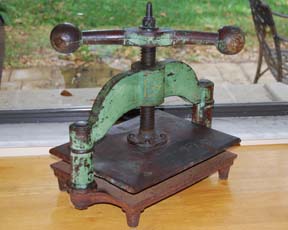Antique Bookpress
Hello. My wonderful husband bought me an antique metal bookpress. I need your help to identify more or less the year it was made. Also, you can see in the picture that it has some rust in the plates and other areas, and some places retain the original green paint. What is the best way to clean it? Any other comment would be appreciated. Thanks.

Bookpress.jpg
You have a very nice bookpress with a lot of “style” to it. Most just have a wheel at the top. I have ten in my own collection, all different. I don;t know if you will ever be able to specifically identify who made your press. Apperently there were a plethora of manufacturers producing these in ther late nineteenth century as almost every bank, law office, etc. needed to have a copypress (bookpress) to be able to make legal copies of documents. There are probably hundreds of different bookpresses out there from what I have observed over the years and I don’t know how well, if at all, their manufacturers are recorded or documented. There is a book that came out a few years ago about copypresses, so maybe someone can post the title of it here.
Again a nice-looking press. The ones with the balls on the end of the handles are a lot less common than the ones with the wheel on the top.
Thank you very much for your observation. I would like to know how should I clean it since I want to use it too. Any suggestions?
I would take clothdogs’ suggestion for gentle rust-removal on the other posting. I actually much prefer the patina of the green paint already on the press. I have a few that I have clleaned-up and repainted over the years and I am somehow not as content with the finished look of any of them. They are literally too-good looking. Your press kind of has a majesty to it that says “I’ve been through the wars” and shows its age proudly. It wont make a lick of difference in how well it prints. When I use mine that have a little rust on the bed and platen, I simply start by placing a sheet of chipboard underneath and on top of whatever I put into the press so that what you are trying to press doesn’t come into contact with the rusty surface.
Thank you. I also like how it looks now, but I wanted to ask the experts. Your comments are very kind and very appreciated since I don’t know much of book making but I want to learn.
The book that Rick mentioned is “Before Photocopying — The Art & History of Mechanical Copying 1780–1938” by Barbara Rhodes and William Streeter, published by Oak Knoll Press. It makes it fairly clear that these were indeed copying presses, for copying letters (book presses opened further, up to 7 or 8”)
Your press, with the ball and lever handle rather than a wheel, is probably mid- to late-1800s. The legs it stands on are an unusual feature. By chance is the handle attached to the screw through a square hole? If so, it closely resembles one of five from unknown makers that the book says are probably “of New England manufacture, and most likely date from the 1840s to the early 1860s.” Possible makers are listed as George C. Taft, C. Whitcomb & Co., C.C. Spring, George Sargent, or Charles Parker Company. Your press looks like it matches an illustration from the Parker Co. 1874 catalogue of their No. 2 press (10 x 13 inches, $8.00), while a decade or so later their No. 2 was a slightly different design.